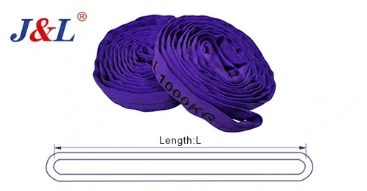What is the Difference Between a Round Sling and a Webbing Sling?
April 8, 2025
First and foremost, the choice of slings in lifting operations is of paramount importance, because it is directly related to the safety and efficiency of the lifting process. Among the mostly used slings are flat slings and round slings. Despite the fact that both are used for lifting and moving heavy things, they are different in terms of their characteristics, materials, and uses.
What is a lifting sling?
Lifting slings are a must in areas such as construction, production, logistics, and the like. They act as the load securing instruments in the lifting process, ensuring the safe and stable operation of the task. The option of round slings and webbing slings will depend on the specific circumstances of the job, which include the nature of the load, weight, required lifting height, and environment, etc.

Round slings
Materials and construction
Among the materials commonly used for manufacturing round slings are polyester, polypropylene, nylon, etc. Specially designed for the highest strength-to-weight ratio, the round slings are very resistant to any abrasion and can be used in the harshest of conditions. The roundness of slings ensures that the load is properly distributed and further provides for safe fixing in the lifting process.
Technical parameters
For instance, the slings of the unit module purple color can load 1000kg, green 2000kg, etc. Round slings come in a very wide range of load capacities and they are always marked with color-coded labels. According to this standard, this type of sling can carry the weights of a few tons to hundreds of tons, which depends on the particular type of slings.
Length: The minimum length is 1 meter, and round slings of different lengths can be used for different lifting applications.
Safety factor: Round slings are manufactured at different Safety Factors such as 6:1, 7:1, and 8:1 to be able to carry six to eight times the weight of the sling without any difficulty.
Application
Round slings are the best lifters for irregular shaped loads due to their flexibility. This allows the sling to very easily take the shape of the load to be lifted. These are the common instances they are found in, construction sites, manufacturing units, and the petrochemical industry.
Webbing Slings
Material and Construction
Webbing slings can be made of polyester, polypropylene or nylon, resulting in a flat, wide webbing that provides a large contact area for the load, thus providing better support.
Technical Specifications
Load Capacity: Webbing slings also come in various load capacities, and the good thing is that they are indicated by the label color. This way, users can easily identify the weight that these slings can really carry.
Width and Length: These are different combinations of webbing sling width and length to meet the lifting needs of different customers. With these combinations, people can more easily get a product that suits their needs.
Safety Factor: Webbing slings usually have a safety factor of 7:1, of course, there are webbing slings with other safety factors.
Applications
Webbing slings are the most flexible and can be applied to a variety of operations, such as machine lifting, cargo transportation in logistics, construction and assembly tasks.
Main Differences Between Round and Webbing Slings
1. Shape and Design
Round Slings: The circular shape of the sling gives it a certain advantage by being able to evenly distribute the weight and at the same time retain flexibility.
Webbing slings: The wide and flat layers of the webbing are the true representation of such, therefore lifting users will be always given a quick and sure grip and a dependable lifting environment provided with every new cooperation.
2. Load handling
Round slings: They can easily cope with the handling of non-standard loads and thus are advantageous in such cases.
Webbing slings: The latter are fine for uniform or flat things and ensure grip security at all points as they fit the load type.
3. Durability and wear resistance
Round slings: The shells on round slings will stop them from breaking or getting worn.
Webbing slings: They may be deteriorated faster if they are used on rough but give wear life and improve durability in the long run.
4. Weight and portability
Round slings: They have a light weight and are easy to handle, which not only facilitates the lifting but also saves the workers’ energy.
Webbing slings: While webbing slings are far bigger in dimension compared with round slings, they give a more stable grip.
Getting to know the difference between round slings and webbing slings is vital for ensuring the safety and efficiency of lifting operations. The distinctive characteristics and applications of both kinds of slings make them the best extraction devices for a variety of age groups and any other endeavors. If you happen to be in need of a round sling or a webbing sling then Juli sling Co., Ltd. will be your best way to get high-quality and reliability lifting solutions.
We are dependable and loyal to all our clients who have given us their loyalty and trust. The satisfaction of our customers is what we strive to achieve! Kindly get in touch with us!
